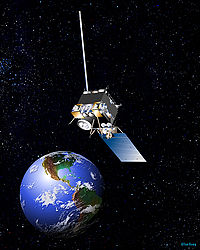Geostationary Operational Environmental Satellite
GOES ( Geostationary Operational Environmental Satellite ) is a series of geostationary weather satellites from the US weather agency NOAA . These form the basis for the weather forecast in the USA, they enable the weather to be monitored around the clock. They are also used for hurricane forecasting and meteorological research.
The satellites orbit the earth in a geostationary orbit , that is, they are fixed over a certain point on the surface. They are all launched from Cape Canaveral Air Force Station . GOES primarily supplies North America and parts of the Pacific and Atlantic with weather information.
The first GOES satellite, GOES-A, was launched in 1975. After a successful start, the satellites are assigned numbers, so GOES-A became GOES-1. To date (2017) a total of sixteen satellites have been put into orbit, another (GOES-G, which was intended to replace GOES-5) was destroyed on May 3, 1986 in a false start.
Former GOES generations
GOES-A to GOES-C
The first series of GOES weather satellites began in 1975 with the launch of GOES-A, which was then renamed GOES-1. GOES-2 and 3 followed in 1977 and 1978. GOES-3 is still used today as a radio relay station between America and the research stations at the South Pole, the other two have been decommissioned. This first generation was manufactured by Ford Aerospace .
GOES-D to GOES-H
The second series satellites were launched between 1980 and 1987. They were later renamed GOES-4 through 7. GOES-G got lost in the event of a false start. The satellites were built by Hughes Aircraft . Today they are decommissioned, with the exception of GOES-7, which is used as a communications satellite for the islands in the Pacific.
GOES-I to GOES-P
The GOES-8 to 12 satellites were manufactured by Space Systems / Loral . GOES-8 was launched in 1994 and has already been decommissioned. GOES-9 was leased to Japan from 2005 to 2009 after being retired by NOAA. It served as a replacement for a disused Japanese satellite, which Japan could not replace in time due to a false start.
GOES-11, or GOES-West, was stationed over the eastern Pacific (135 ° West) and provided weather data to California until 2011, while GOES-12, or GOES-East, (75 ° West) was for the central and eastern regions until 2013 Parts of the US was responsible.
With the launch of GOES-N (GOES-13) on May 24, 2006 on board a Delta IV Medium + , the first model developed by Boeing was launched. It is 4.2 meters long, 1.9 meters in diameter and has a takeoff weight of 3.1 tons. The satellite's two main instruments were a camera and radiometer , which provided high-resolution images in both the visible and infrared regions of the spectrum . In addition, temperature and moisture distributions in the atmosphere could be measured. After a test phase, the satellite was handed over to NOAA in 2010 and put into service. It was shut down on January 8, 2018.
The structurally identical GOES-O (GOES-14) was also transported into orbit by a Delta IV on June 27, 2009, GOES-P (GOES-15) followed on March 4, 2010.
Current generation
In May 2016, GOES-14, 15, and 16 were NOAA's active weather satellites. GOES-16 was launched on November 19, 2016; GOES-S followed on March 1, 2018. Both satellites were a Atlas V launch. NASA's Space Environment In-Situ Suite (SEISS) instrument flies on the satellite satellites from GOES-R or -16 and measures energetic particles in space.
GOES-T and GOES-U are planned for 2020 and 2024 at the earliest .
See also
Web links
Individual evidence
- ^ GOES-3 Satellite Transfer from NOAA to NSF. NSF, September 27, 1997, archived from the original on May 2, 2016 ; accessed on February 12, 2010 (English).
- ↑ GOES-15 Satellite Is Activated and GOES-11 Deactivated After Nearly 12 Years In Orbit. NASA, December 8, 2011, accessed January 30, 2017 .
- ↑ After 10 years of service, NOAA retires GOES-12 satellite. August 23, 2013, accessed January 23, 2017 .
- ↑ GOES-13 is America's New GOES-EAST Satellite. April 16, 2010, accessed January 23, 2017 .
- ^ NOAA: Farewell to GOES-13: The History of NOAA's Former GOES East Satellite. January 10, 2018, accessed January 7, 2019 .
- ↑ GOES-O launch. NASA, June 27, 2009, accessed September 24, 2009 .
- ↑ NASA's Shuttle and Rocket Launch Schedule. NASA, accessed February 12, 2010 .
- ↑ NASA Awards NOAA GOES-R Instrument Contract. NASA, August 24, 2006, accessed August 24, 2006 .
- ↑ Lockheed Martin halts work on GOES-T to wait for instrument fix. In: Spacenews. January 9, 2019, accessed June 17, 2019 .


